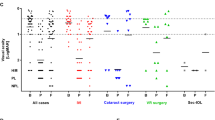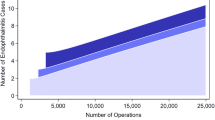Abstract
Aims To estimate the incidence of acute-onset presumed infectious endophthalmitis (PIE) following cataract surgery in the UK and provide epidemiological data on the presentation, management, microbiology, and outcome of cases of endophthalmitis.
Methods Cases were identified prospectively by active surveillance through the British Ophthalmological Surveillance Unit reporting card system, for the 12-month period October 1999 to September 2000 inclusive. Questionnaire data were obtained from ophthalmologists throughout the UK at baseline and 6 months after diagnosis. Under-reporting was estimated by independently contacting units with infection databases.
Results Data were available on 213 patients at baseline and 201 patients at follow-up. The minimum estimated incidence of PIE was 0.086 per 100 cataract extractions and the corrected incidence was 0.14 per 100 cataract extractions. For the management of PIE, 96% of patients received intravitreal, 30% subconjunctival, 65% oral, and 17% intravenous antibiotics. In all, 17% of patients received intravitreal steroid. From the intraocular samples taken for microbiological analysis, 56% were culture positive. At follow-up, 48% of patients achieved visual acuity of 6/12 or better and 66% achieved better than 6/60. 13% of patients were unable to perceive light or had evisceration of the globe.
Conclusions The incidence of PIE after cataract surgery in the UK is comparable to that of other studies. Approximately 50% of patients achieved a visual acuity close to the driving standard.
Similar content being viewed by others
Log in or create a free account to read this content
Gain free access to this article, as well as selected content from this journal and more on nature.com
or
References
Fisch A, Salvanet A, Prazuck T, Forestier F, Gerbaud L, Coscas G et al. Epidemiology of infective endophthalmitis in France. The French Collaborative Study Group on Endophthalmitis. Lancet 1991; 338 (8779): 1373–1376.
Schmitz S, Dick HB, Krummenauer F, Pfeiffer N . Endophthalmitis in cataract surgery: results of a German survey. Ophthalmology 1999; 106 (10): 1869–1877.
Aaberg Jr TM, Flynn Jr HW, Schiffman J, Newton J . Nosocomial acute-onset postoperative endophthalmitis survey. A 10-year review of incidence and outcomes. Ophthalmology 1998; 105 (6): 1004–1010.
Desai P, Minassian D.C, Reidy A . National cataract surgery survey 1997–1998: a report of the results of the clinical outcomes. Br J Ophthalmol 1999; 83: 1336–1340.
Foot B, Stanford M, Rahi J, Thompson J . The British Ophthalmological Surveillance Unit: an evaluation of the first 3 years. Eye 2003; 17: 9–15.
Endophthalmitis Vitrectomy Study Group. Results of the Endophthalmitis Vitrectomy Study. Arch Ophthalmol 1995; 113: 1479–1496.
Thacker SB, Redmond S, Berkelman RL . A controlled trial of disease surveillance strategies. Am J Prev Med 1986; 2: 345–350.
Vogt RL, LaRue D, Klaucke DN, Jillison DA . Comparison of an active and passive surveillance system of primary care providers for hepatitis, measles, rubella and salmonellosis in Vermont. Am J Public Health 1983; 73: 795–797.
Foot BG, Stanford MR . Questioning Questionnaires. Eye 2001; 15: 693–694.
Hughes DS, Hill RJ . Infectious endophthalmitis after cataract surgery. Br J Ophthalmol 1994; 78 (3): 227–232.
Olson JC, Flynn Jr HW, Forster RK, Culbertson WW . Results in the treatment of postoperative endophthalmitis. Ophthalmology 1983; 90 (6): 692–699.
Okhravi N, Adamson P, Matheson MM, Towler HM, Lightman S . PCR-RFLP-mediated detection and speciation of bacterial species causing endophthalmitis. Invest Ophthalmol Vis Sci 2000; 41 (6): 1438–1447.
Hykin PG, Tobal K, McIntyre G, Matheson MM, Towler HM, Lightman SL . The diagnosis of delayed post-operative endophthalmitis by polymerase chain reaction of bacterial DNA in vitreous samples. J Med Microbiol 1994; 40 (6): 408–415.
Therese KL, Anand AR, Madhavan HN . Polymerase chain reaction in the diagnosis of bacterial endophthalmitis. Br J Ophthalmol 1998; 82 (9): 1078–1082.
Barza M, Pavan PR, Doft BH, Wisniewski SR, Wilson LA, Han DP et al. Evaluation of microbiological diagnostic techniques in postoperative endophthalmitis in the Endophthalmitis Vitrectomy Study. Arch Ophthalmol 1997; 115 (9): 1142–1150.
Peyman GA . Antibiotic administration in the treatment of bacterial endophthalmitis. II. Intravitreal injections. Surv Ophthalmol 1977; 21 (4): 332, 339–346.
Davidson SI . Post-operative bacterial endophthalmitis. Trans Ophthalmol Soc UK 1985; 104 (Part 3): 278–284.
Okhravi N, Towler HM, Hykin P, Matheson M, Lightman S . Assessment of a standard treatment protocol on visual outcome following presumed bacterial endophthalmitis. Br J Ophthalmol 1997; 81 (9): 719–725.
Murray DC, Christopoulou D, Hero M . Intravitreal penetration of teicoplanin (letter; comment). Eye 1999; 13 (Part 4): 604–605.
Campochiaro PA, Conway BP . Aminoglycoside toxicity—a survey of retinal specialists. Implications for ocular use (see comments). Arch Ophthalmol 1991; 109 (7): 946–950.
Park SS, Vallar RV, Hong CH, von Gunten S, Ruoff K, D’Amico DJ . Intravitreal dexamethasone effect on intravitreal vancomycin elimination in endophthalmitis. Arch Ophthalmol 1999; 117 (8): 1058–1062.
Shah GK, Stein JD, Sharma S, Sivalingam A, Benson WE, Regillo CD et al. Visual outcomes following the use of intravitreal steroids in the treatment of postoperative endophthalmitis. Ophthalmology 2000; 107 (3): 486–489.
Harris MJ . Visual outcome after intravitreal steroid use for postoperative endophthalmitis. Ophthalmology 2001; 108 (2): 240–241.
The Royal College of Ophthalmologists. Guidance for Clinical Governance in Ophthalmology. 8. 1999. Ref Type: Report.
Acknowledgements
We are very grateful for the support of the British Ophthalmological Surveillance Unit.
We thank Mr MD Cole, Torbay Hospital and Professor S Lightman, Institute of Ophthalmology, London for providing helpful advice.
This work was supported by the British Medical Association Middlemore and John William Clarke awards, for which we are grateful.
We particularly thank the following Ophthalmologists for helping with the data collection for our study: Mr SP Aggarwal, Mr BDS Allan, Mr ED Allen, Mr N Anand, Mr S Armstrong, Mr MW Austin, Mr PJ Bacon, Dr T Barrie, Mr R Bates, Mr AK Bates, Mr JDL Beare, Mr MA Bearn, Mrs L Beck, Mr B Beigi, Dr GJB Bedford, Dr RWD Bell, Mr PD Black, Mr RC Bosanquet, Mr DC Broadway, Mr RL Burton, Miss ZA Butt, Mr AB Callear, Mr SH Campbell, Mr C Canning, Mr AG Casswell, Miss M Chatterjee, Mr SK Choudhuri, Mr M Clowes, Mr SD Cook, Miss M Corbett, Mr PG Corridan, Mr EA Craig, Mr JKG Dart, Mr RB Dapling, Mr D David, Mr C Dees, Mr SP Desai, Mr J Deutsch, Mr D Dhingra, Mr CJM Diaper, Professor A Dick, Mr RS Edwards, Mr M Ekstein, Mr IR Fearnley, Dr AI Fern, Mr TJ Fetherston, Miss L Ficker, Mr FF Fisher, Mr Fouladi, Miss W Franks, Mr LB Freeman, Mr TJ Freegard, Dr MP Gavin, Mr PTS Gregory, Mr BP Greaves, Mr AK Gupta, Mr M Harris, Mr AA Hashim, Mr S Hardman Lea, Mr W Hoe, Mr IH Hubbard, Mr RC Humphry, Mr DS Hughes, Mr JR Innes, Mr DV Inglesby, Mr B James, Mr JSH Jacob, Mr D Jones, Mr PW Joyce, Mr J Keast-Butler, Mr MG Kerr-Muir, Mr T Leslie, Mr SG Levy, Mr J Lipton, Mr CSC Liu, Mr D Lloyd-Jones, Miss AL Lyness, Mr TD Manners, Dr CJ MacEwen, Professor D Mcleod, Mr JN McGalliard, Mr JMS McConnell, Dr Moosavi, Mr AT Moore, Mr SJ Morgan, Mrs CE Morton, Mr A Murray, Professor PI Murray, Dr SB Murray, Dr RI Murray, Mr ME Nelson, Mr BJ McNeela, Mr NP O’Donnell, Mr G O’Connor, Mr CO Peckar, Mr RV Pearson, Mr RP Phillips, Mr P Phelan, Mr W Pollock, Mr K Potu, Mr S Rassam, Professor IG Rennie, Mr RM Redmond, Mr T Rimmer, Mr PH Rosen, Mr J Shah, Mr D Steele, Dr IG Syme, Mr C Stevenson, Mr RJ Stirling, Mr P Sullivan, Miss HC Seward, Mr JH Sandford-Smith, Mr KP Stannard, Mr G Sturrock, Mr T Shetti, Miss SN Stefanous, Mr SJ Talks, Mr V Thaller, Mr GM Thompson, Mr NMG Toma, Mr S Tuft, Mr AB Tullo, Mr AG Tyers, Mr S Verghese, Mr AJ Vivian, Miss A Walker, Mr J Wallace, Mr RF Walters, Mr JNF West, Ms S Weber, Dr IF White, Mr ACA While, Mr WH Woon, Mr R Wormald.
Author information
Authors and Affiliations
Corresponding author
Rights and permissions
About this article
Cite this article
Kamalarajah, S., Silvestri, G., Sharma, N. et al. Surveillance of endophthalmitis following cataract surgery in the UK. Eye 18, 580–587 (2004). https://doi.org/10.1038/sj.eye.6700645
Received:
Accepted:
Published:
Issue date:
DOI: https://doi.org/10.1038/sj.eye.6700645
Keywords
This article is cited by
-
The Royal College of Ophthalmologists’ National Ophthalmology Database Study of Cataract Surgery: Report 13, monitoring post-cataract surgery endophthalmitis rates—the rule of X
Eye (2024)
-
Initial experiences of cataract & lens surgery in 1269 patients in outpatient clean rooms using a portable laminar air flow device
Eye (2023)
-
The incidence, presenting clinical findings and treatment patterns of Birdshot Retinochoroiditis in a high-prevalence region: findings from Northern Ireland, England and Wales
Eye (2023)
-
Therapie der postoperativen Endophthalmitis
Der Ophthalmologe (2021)
-
Incidence of submacular haemorrhage (SMH) in Scotland: a Scottish Ophthalmic Surveillance Unit (SOSU) study
Eye (2019)



